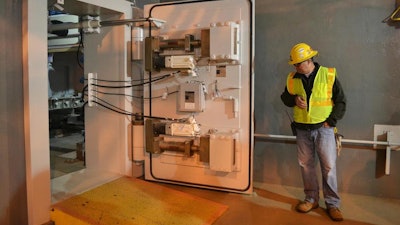
RICHMOND, Ky. (AP) — Deadly chemical weapons held for decades in central Kentucky will soon be sent to "the ash heap of history," Senate Majority Leader Mitch McConnell said Wednesday at a gathering of political and military leaders near the facility where they are to be methodically destroyed.
The gathering marked a ceremonial beginning of the process to eliminate more than 500 tons (453.6 metric tons) of mustard gas, sarin or VX agent stored at an Army depot near Richmond, some since the 1940s. A start date has not been set.
"Today is much more than a ribbon cutting," McConnell told a crowd of a few hundred people at the Blue Grass Army Depot. "It's getting one step closer to fulfilling the Army's promise to the people of Madison County."
McConnell has steered millions of federal dollars to the effort, dating back to the mid-1990s.
The military initially planned to destroy the weapons in Kentucky by burning them, but the facility built in Richmond will use water and chemicals to neutralize the agents.
"Today marks the beginning of the last chapter of U.S. efforts to eradicate chemical weapons from the face of the earth," Charles Ball, a deputy secretary of defense, said during the 90-minute ceremony. Ball said the US has destroyed about 90% of its stockpile, much of it built up during the Cold War.
Another stockpile of weapons in Colorado is currently being eliminated, and about a quarter of its 2,600 tons (2,358.7 metric tons) are gone. The two caches are the last remaining in the U.S. The facility near Pueblo has been marred by cost overruns and two shutdowns because of leaks in storage tanks, rust inside shells and vibration in pipes. The Army said in March it wants to spend an additional $60 million to build two detonation chambers to destroy thousands of shells at the Colorado facility.
The Kentucky facility was completed in 2015 and the military and private contractors have spent the intervening years training for the destruction process. The Kentucky weapons are scheduled to be eliminated by 2023.
Finding an alternative to burning the weapons has been a pet project of McConnell's for decades. Residents here were concerned about the military's plan to incinerate the weapons, since they were stored just a few dozen miles away from Kentucky's second-largest city.
Over the years, McConnell has secured funding to explore different destruction methods; helped stop the construction of an incineration facility the Army wanted; and steered millions to pay for the project.
The facility has blast-proof rooms with 2-feet (0.61-meters) thick concrete that can contain an explosion. Plant workers will dismantle the weapons and mix the nerve agents with chemicals and water.






















